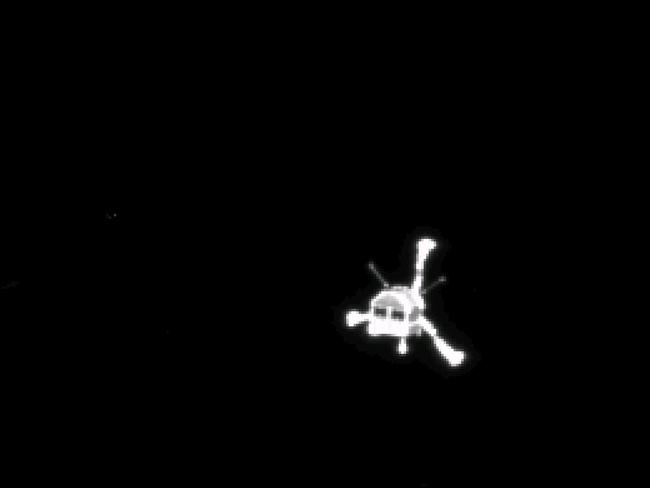Rosetta mission: Probe Philae lands on comet for first time in pioneering space mission
THE European Space Agency has made history - landing a washing machine-sized spacecraft on a comet speeding through our solar system at 66,000km/hr.
THE European probe Philae has made the first-ever landing on a comet, a crowning phase in a quest to explore the origins of the Solar System, but there are concerns over whether it is fastened securely enough to carry out its mission.
The European Space Agency (ESA) said the robot lab landed on Comet 67P/Churyumov-Gerasimenko around seven hours after separating from its mother ship Rosetta more than 510 million kilometres from home, it said.
“Philae is talking to us,” said Stephan Ulamec, the lander’s manager. “We are on the comet.”

But the announcement was soon followed by worries that Philae may have landed in soft material and was not properly attached.
Hang on in there Philae! MT @Philae2014: I’m on the surface but my harpoons did not fire. My team now trying to determine why. #CometLanding
— ESA Rosetta Mission (@ESA_Rosetta) November 12, 2014The 100-kilogram lander separated from its mother ship, Rosetta, after a trek lasting a decade and covering 6.5 billion kilometres.
.@ESA_Rosetta See for yourself! ROLIS imaged #67P when we were just 3km away! Glad I can share. #CometLanding pic.twitter.com/b6mcid2fsn
— Philae Lander (@Philae2014) November 12, 2014At the ESA’s operations centre in Darmstadt, Germany, a crowd of scientists, guests and VIPs -- including the two Ukrainian astronomers who first spotted the comet in 1969 -- cheered at the announcement of the landing, the centrepiece of one of the riskiest projects in space exploration.
“This is a big step for human civilisation,” said the agency’s director general, Jean-Jacques Dordain, as a crowd of scientists, guests and VIPs cheered and applauded in relief.
“Touchdown! My new address: 67P!,” Philae’s team tweeted.
TOUCHDOWN for @Philae2014! #CometLanding pic.twitter.com/ZMBeB8ng3h
— ESA Rosetta Mission (@ESA_Rosetta) November 12, 2014“Our ambitious Rosetta mission has secured another place in the history books,” he said. “Not only is it the first to rendezvous with and orbit a comet, but it is now also the first to deliver a probe to a comet’s surface.”
Our Dr. Jim Green congratulates @ESA on #CometLanding: "How audacious! How exciting! How unbelievable!" pic.twitter.com/4QKAgLaN3k
— NASA (@NASA) November 12, 2014On behalf of NASA, @SciAstro sends our congrats to @ESA on their #CometLanding achievement: http://t.co/R6ua9eRod5 pic.twitter.com/tAipDdoO32
— NASA (@NASA) November 12, 2014Scientists hope the lander, equipped with 10 instruments, will unlock the secrets of comets — primordial clusters of ice and dust that may have helped sow life on Earth.

The 1.3 billion euro ($1.95 billion) Rosetta mission was approved in 1993.
Rosetta was hoisted into space in 2004, and took more than a decade to reach its target, which it did in August this year, having used the gravitational pull of Earth and Mars as slingshots to build up speed.

#cometlanding Hooray!!!!
— William Shatner (@WilliamShatner) November 12, 2014NASA congratulated ESA on the landing.
The following statement is from, astronaut and in Washington, about the successful comet landing by the European Space Agency’s Rosetta spacecraft:
“This achievement represents a breakthrough moment in the exploration of our solar system and a milestone for international cooperation,” said John Grunsfeld, associate administrator for NASA’s Science Mission Directorate. “The data collected by Rosetta will provide the scientific community, and the world, with a treasure-trove of data. Small bodies in our solar system like comets and asteroids help us understand how the solar system formed and provide opportunities to advance exploration. We look forward to building on Rosetta’s success exploring our solar system through our studies of near earth asteroids and NASA’s upcoming asteroid sample return mission OSIRIS-REx. It’s a great day for space exploration.”

Philae was designed to settle down at a gentle 3.5 km per hour, firing two harpoons into the hope that the comet surface -- a complete unknown -- would give it grip.
Ice screws at the end of its three legs were then to drive into the low-gravity comet to stop the probe bouncing back into space.
In a final health check before separation, a problem was detected with the small thruster on top of Philae that was designed to counteract the recoil.
And after landing, questions arose whether the craft was secured.
“There are some indications that they (the harpoons) might not have been fired, which could mean that we are sitting in soft material and we are not anchored,” said Ulamec.
“We have to analyse what is the actual situation.”
Philae’s work program includes drilling into the surface of comet “67P” and analysing the sample for telltale isotopes in water and complex carbon molecules.
It has enough battery power to provide about 60 hours of work, but can continue until March with a solar recharge.
According to a leading theory, comets pounded the fledgling Earth 4.6 billion years ago, providing it with carbon molecules and precious water -- part of the tool kit for life.



